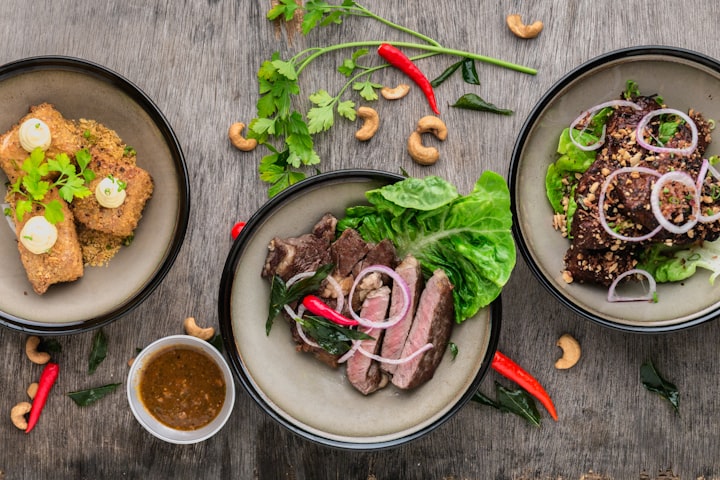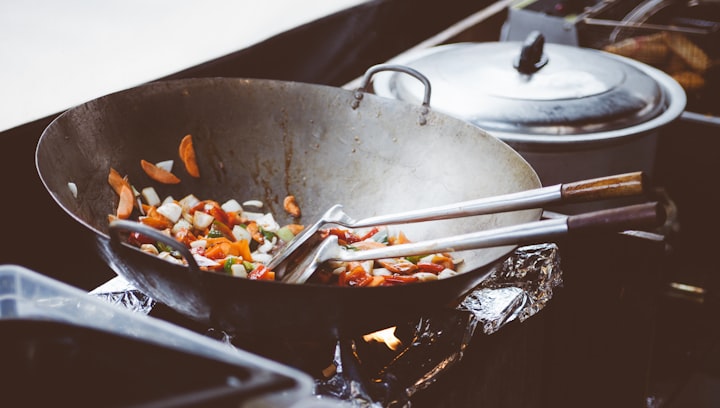How to Cook So You'll Actually Eat at Home
Why make something you don't want to eat?

Tasteless food isn't tasty
Imagine this. It's a weeknight. You just finished work and you're starving. There are leftovers in the fridge. It's dried chicken breast, bland steamed broccoli and a container of plain brown rice. You've been trying to eat more at home because it's better for your pocket and your waistline.
Even though you're ravenous, it doesn't appeal to you. You pick up the phone and order from your favourite pizza place. 20 minutes later and you're sitting on the couch, one hand on the remote and another stuffing your face with that cheesy pie goodness.
You end up throwing out the leftovers and starting fresh when you go grocery shopping. All that wasted food, money and effort makes me want to cry not just because I'm a frugal Asian mom but because I'm a huge foodie.
I love food
I'm Chinese so it's almost implied I love food. I started cooking when I was barely 10 years old. It's like how all Asian kids know how to properly cook rice with the finger method.
My mom taught me a few skills but mostly, I learned from watching the Food Network and having free reign in the kitchen when I was growing up. I enjoy cooking but I also love eating out.
It gives me the utmost joy when I get the opportunity to go to a restaurant and have a meal. It's an adventure because I get to eat food that I don't make at home. This includes anything fried, sushi, pho, Dim Sum, sandwiches, Korean BBQ and the list goes on. Oh the flavours, textures, smells, umami…
Eating home-cooked meals saves you money and improves your health
I'd love to 'finger cook' every night. However, with 2 growing kids and a husband whose appetite doesn't match his body (Asian metabolism), it can get pretty expensive. In addition, eating home-cooked meals can improve our diets, reduce caloric intake, and help us live healthier lives.
So for most of our meals, we eat at home. Our family goes out or gets take-out one meal per week. Through the 20+ years of cooking at home, I've learned a few tricks that can make any leftovers enticing, preventing you from picking up the phone or heading out for a bite.
Don't fear the F word
For 40 years, we were advised that a low-fat, high-carb diet is what helps people stay lean and healthy. And only recently, that was considered a 'failed experiment' since the rates of obesity and diabetes actually skyrocketed. As per The John Hopkins' Patient Guide To Diabetes, fat doesn't increase body weight, raise cholesterol, or blood glucose.
Don't let these myths affect the way you cook. Fat makes food taste delicious and it slows down digestion, keeping you full longer. However, you don't need to order from a restaurant to have a delicious meal.
Add oil!
Canola, vegetable, coconut, olive, grape seed, peanut, corn…
Did you know that the main purpose of using oil when cooking isn't to prevent food from sticking to your pan?
First, the oil acts as a conductor so that the food can heat up not just on the parts that touch the surface of your pan. So that's why restaurants always serve evenly cooked meats and vegetables.
Next, oil is a flavour carrier, making your food taste better by enhancing the flavours. So use that sumptuous fatty dressing instead of the lacklustre fat-free one to invigorate that 'boring' salad. A bonus benefit is that it eating raw vegetables with some fat helps you absorb valuable nutrients. Nutritious and delicious is a win-win!
Lastly, you know that yummy, browned crust you get from biting into pan-fried dumplings, cookies, or a seared steak? Oil made that happen by enabling the Maillard reaction, a chemical reaction between amino acids and reducing sugar that creates that distinctive taste.
The next time you're roasting vegetables, add some oil to help encourage browning. It helps eliminate that raw taste by enhancing its rich and toasty flavours, making you feel like a chef prepared it for you.
So add oil in life (for my Cantonese peeps) and in cooking.
Come to the Dark Side
When it comes to a flavour contest, dark meat wins, hands down! There is a higher fat content in dark meat compared to white but that's not all that makes it taste better.
Dark meat (wings, thighs and drumsticks) consists of muscles that contain a higher proportion of myoglobin (50%) than white meat (10%). Myoglobin is what makes meat have a gamey taste, keeping it flavourful and juicy.
White meat (breast) has a lower proportion of myoglobin and so it tends to be milder in taste and drier in texture. It's easier to overcook, giving you those balls of string in your mouth that no amount of chewing could break down.
Mix it up with regular ground beef
I love ground turkey meat but it can taste like cardboard if there's no flavour. I don't even glance at the ground chicken breast when I'm at the grocery store (expensive and tasteless)
Regular ground beef is incredibly flavorful and juicy because it contains a high proportion of fat (25–30%). It's also the cheapest. However, when it gets cooked, it shrinks down quite a bit; therefore, I like to do a mixture of regular and lean ground meat when making meatballs, pasta sauces, burgers and meatloaf.
Keep The Drippings
Remember that episode of Friends where Monica (a chef) kept a bowl of chicken fat in the apartment and Chandler tricks Joey into drinking it?
Why did she keep a dish of chicken fat?
It adds incredible flavour to all sorts of dishes. Whenever I'm roasting a duck, cooking bacon or braising beef brisket, I always drain or skim the fat into a little dish and keep it in my fridge. The next time you're sauteing vegetables, making fried rice or mashing potatoes, add a scoop of bacon fat, and you won't have leftovers.
Bottom line: Don't be afraid of the F word. Fat isn't bad. Fat isn't evil. Eating fat doesn't make you fat.
Get Salty and Saucy
Did you know that the purpose of adding salt when cooking isn't to make food salty?
It's to enhance the existing flavours of the food. That's why hot chocolate tastes so good when you add a pinch of salt. Or what about salted caramel? Or salted egg yolk?
Veggies put their walls up and need time to warm up
Want to actually eat your vegetables and not push them to the side of your plate, dreading them like a dental check-up?
Season them early so they taste like a side dish you'd pay for.
Vegetables are made up of plant cells and plant cells have two rigid walls that surround them. Salt needs to penetrate both walls before fully immersing its flavour-boosting abilities. Therefore, when cooking vegetables, add salt at the beginning to give them enough time to mingle and distribute evenly throughout.
Taste while you cook
When ingredients are safely cooked enough, take a small portion out and taste it. Delicious? Or needs a bit more flavour?
Doing this throughout your cooking process will help determine how much salt to add. Tasting while you cook allows you to understand and become more aware of how much salt is being added to your food.
You may even realize you enjoy your food with a little less salt than what restaurants cook with. In addition, this helps you practice mindfulness as you taste every bite thoroughly with intention, gauging the intensity of flavours and seasonings.
Become your own sauce boss
I love sauces. I was never one of those butter and noodles or plain rice type of kids. I want my food to touch each other so that I could taste how one flavour affects the other. When I get a chance to go to a buffet, I'm the one who has sweet and sour pork on top of a salad with blobs of roasted garlic mashed potatoes, drizzled with ketchup and gravy on top.
But you don't need to be a messy food aficionado to appreciate sauces. One of my favourite go-to sauces is soy sauce.
I use this in all types of cuisine, not just Asian cooking, to add that umami flavour, enhancing the other flavours of food (sweet, bitter, sour, salty). A few drops of this and some sesame oil on top of an egg fried in bacon fat beats eating tasteless, rubbery scrambled eggs.
Bottom line: start seasoning your food with a bit of salt and sauce and adjust as you go so that you'll get a better sense of how much you actually enjoy
Some sweetness goes a long way
When you go out for sushi, you're probably thinking it's the healthiest meal you can eat because there is no added fat or sugar in that salmon maki so you go and make a triple order plus a couple of tasty things like an order of gyoza and a crazy roll to "balance out" your "healthy choice".
Hold on a sec, sushi rice tastes damn good because it contains salt, rice vinegar and sugar. Then when you dunk that salmon rice nugget into soy sauce, you've created a flavour trifecta, balancing the sweet, sour, and salty with a touch of umami. And spicy if you've used wasabi.
Sweet meat
What do fall off the bone baby back ribs, sumptuous beef bulgogi and tender pork siu mai have in common?
Some form of sugar has been added to the meat.
Smothering some brown sugar on baby back ribs before they get on the grill or oven helps induce the Maillard reaction (mentioned above) between the amino acids and sugar, giving that delectable taste.
Adding a few teaspoons of white sugar into siu mai meat mixture helps bring out the sweetness and balance the savouriness of the minced pork and shrimp.
What's the secret to bulgogi beef? The marinade not only has sugar but crushed fruit like kiwi or pear that helps tenderize the meat and gives it that distinctive sweet flavour.
So the next time you're making a meat dish, add a bit of sugar and see where that takes you.
Sweet Italian sauce
I never buy pasta sauce or pizza sauce from the store. I make my own using canned tomatoes and tomato paste. But using only that creates a very tangy and bland sauce. If you've ever looked at the ingredient list for store-bought frozen pizza, lasagnas, canned pasta or microwave dinners, you'll be surprised how much sugar has been added to it.
But you won't need to add the same amount because a little will do. Pizza sauce is one of the easiest things to make. You can make yours with a can of tomato paste, water, salt, sugar and oregano.
The next time you're craving pasta, instead of getting takeout from your favourite Italian joint, grab a can of crushed tomatoes, some butter, garlic and onions and start exploring by adding some salt, sugar, and herbs to the mix.
Still tangy? A bit of sugar.
No flavour? A pinch of salt
Not fragrant enough? A sprinkle of herbs
Keep tasting and adjusting as you go and you'll be surprised how much it tastes like a restaurant's.
Bottom line: Adding a bit of sweetness to your cooking can go a long way. It's not just for desserts.
What's the point of cooking?
Cooking at home allows you to control what goes into your meals. And adding fat, salt and sugar to your food may seem like it defeats the purpose of having a healthy diet. However, moderation is key and once you've adapted the ability to taste while cooking and adjusting as you go, you'll realize these ingredients are worth way more than their weight in gold.
And of course, the real reason why anyone cooks is to eat. If you don't want to eat what you've cooked, why cook in the first place?
This was originally published on my website on December 30, 2020
About the Creator
Katharine Chan
Sum (心, ♡) on Sleeve | Author. Speaker. Wife. Mom of 2 | Embrace Culture. Love Yourself. Improve Relationships | Empowering you to talk about your feelings despite growing up in a culture that hid them | sumonsleeve.com/books






Comments
There are no comments for this story
Be the first to respond and start the conversation.